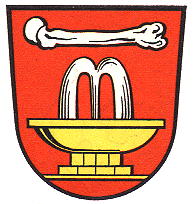Beinstein: Difference between revisions
Knorrepoes (talk | contribs) (Created page with '{|width="100%" style="color:black; background-color:#ffffcc;" |width="15%"|50 px|left |width="70%" align="center" |'''Heraldry of the World<br/>Civic heraldr…') |
Knorrepoes (talk | contribs) m (Text replace - "[[Literature" to "{{media}} [[Literature") |
||
| Line 23: | Line 23: | ||
The fountain in the lower half of the arms symbolises the mineral springs in the area. | The fountain in the lower half of the arms symbolises the mineral springs in the area. | ||
{{media}} | |||
[[Literature]] : Stadler, K. : Deutsche Wappen - Bundesrepublik Deutschland. Angelsachsen Verlag, 1964-1971, 8 volumes. | [[Literature]] : Stadler, K. : Deutsche Wappen - Bundesrepublik Deutschland. Angelsachsen Verlag, 1964-1971, 8 volumes. | ||
Revision as of 18:41, 8 July 2014
| Heraldry of the World Civic heraldry of Germany - Deutsche Wappen (Gemeindewappen/Kreiswappen) |
BEINSTEIN
State : Baden-Württemberg
District (Kreis) : Rems-Murr Kreis (until 1973 Waiblingen)
Incorporated into : 1971 Waiblingen
Official blazon
In Rot unter einem liegenden silbernen Oberschenkelknochen eine goldene Brunnenschale mit silbernem Sprudel.
Origin/meaning
The arms were granted in 1952.
The canting bone (Bein) in the chief was already shown in the local village dating from 1454. All later seals and images of the village showed a bone, in our without a shield. In the early 20th century the arms were granted and showed the bone in a red field.
The fountain in the lower half of the arms symbolises the mineral springs in the area.
Contact and Support
Partners:
Your logo here ?
Contact us
© since 1995, Heraldry of the World, Ralf Hartemink 
Index of the site
Literature : Stadler, K. : Deutsche Wappen - Bundesrepublik Deutschland. Angelsachsen Verlag, 1964-1971, 8 volumes.











